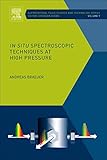In situ spectroscopic techniques at high pressure / edited by Andreas Braeuer.
Series: Supercritical fluid science and technologyPublisher: Amsterdam, Netherlands : Elsevier, 2015Description: 1 online resourceContent type:- text
- computer
- online resource
- 9780444634207
- 0444634207
- 543/.5 23
- QC451
Includes index.
Includes bibliographical references at the end of each chapters and index.
Cover; Title page; Copyright; Contents; Foreword; Preface; List of Abbreviations and Parameters; Abbreviations and Acronyms; Parameters in Latin letters; Parameters in Greek letters; Constants; Indices; Chapter 1 -- High Pressure: Fellow and Opponent of Spectroscopic Techniques; 1.1 -- Compressible fluids in high-pressure process technology; 1.2 -- Spectroscopic techniques bring light into the darkness of high-pressure processes; 1.3 -- Why high pressure is an opponent of spectroscopic techniques?; 1.4 -- Why high pressure is a fellow of spectroscopic techniques?
1.5 -- Advantages of spectroscopic techniques1.5.1 -- Non-invasive Measurement Principle of In Situ Spectroscopic Techniques; 1.5.2 -- Temporal Resolution and Sampling Rates of In Situ Spectroscopic Techniques; 1.5.3 -- Spatial Resolution of In Situ Spectroscopic Techniques; 1.5.4 -- Dimensionality of In Situ Spectroscopic Techniques; 1.5.4.1 -- Zero-Dimensional Spectroscopy (Point Measurements); 1.5.4.2 -- One-Dimensional Spectroscopy; 1.5.4.3 -- Two-Dimensional Spectroscopy; 1.6 -- Exercises corresponding to Chapter 1; Exercise 1.1: Temporal Resolution and Sampling Rate; Tasks: Exercise 1.1
Answers: Exercise 1.1Exercise 1.2: Spatial Resolution; Tasks: Exercise 1.2; Answers: Exercise 1.2; Exercise 1.3: Spatial Resolution; Tasks: Exercise 1.3; Answers: Exercise 1.3; 1.7 -- Appendix-Chapter 1; 1.7.1 -- Supercritical Fluids; 1.7.1.1 -- What is a Supercritical Fluid?; 1.7.1.2 -- What Makes a Supercritical Fluid Attractive for Process Engineers?; 1.7.1.2.1 -- Supercritical Fluids are Compressible; 1.7.1.2.2 -- Supercritical Fluids Feature a Low Viscosity; 1.7.1.2.3 -- Conductivity and Capacity of Heat of Supercritical Fluids; 1.7.1.3 -- What is a Supercritical Mixture?
1.7.1.3.1 -- Pressure-Composition (Px) Diagram of Binary Mixtures1.7.1.3.2 -- What is the Mixture Critical Point?; 1.7.2 -- Supercritical Anti-solvent (SAS) Process; References; Chapter 2 -- Interaction of Matter and Electromagnetic Radiation; 2.1 -- Properties of electromagnetic radiation and photons; 2.1.1 -- Equation of a Harmonic Wave; 2.1.2 -- Polarisation of the Electric Field; 2.1.3 -- Spectrum of Electromagnetic Radiation; 2.1.4 -- Energy and Momentum of a Photon; 2.1.5 -- Exercises Corresponding to Section 2.1; Exercise 2.1: Wave Function I; Task: Exercise 2.1; Answer: Exercise 2.1
Exercise 2.2: Wave Function IITask: Exercise 2.2; Answer: Exercise 2.2; Exercise 2.3: Wave Function III; Task: Exercise 2.3; Answer: Exercise 2.3; Exercise 2.4: Photons and Continuous-Wave Laser; Task: Exercise 2.4; Answer: Exercise 2.4; Exercise 2.5: Peak Power and Average Power of Pulsed Laser; Task: Exercise 2.5; Answer: Exercise 2.5; 2.2 -- Properties of molecules; 2.2.1 -- Specific Heat Capacity of a Gas; 2.2.2 -- Translational Energy; 2.2.3 -- Rotational Energy of a Diatomic Molecule; 2.2.4 -- Vibrational Energy of a Diatomic Molecule; 2.2.5 -- Electronic Energy
2.2.6 -- Energy of Molecules Relevant for Spectroscopy
Online resource; title from PDF title page (ScienceDirect, viewed December 17, 2015).
Elsevier ScienceDirect All Books
There are no comments on this title.

